Paving Recycled Asphalt Product (R.A.P.)
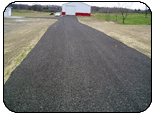 Recycled asphalt is a product of old asphalt that is ground into gravel. This product has much of the original oils still in it. After installation, the heat from the sun releases the oils and binders to help melt the gravel into one uniform piece of pavement.
Recycled asphalt is a product of old asphalt that is ground into gravel. This product has much of the original oils still in it. After installation, the heat from the sun releases the oils and binders to help melt the gravel into one uniform piece of pavement.
The paving process starts out the same. Proper grading and excavation is required to ensure adequate water run off.
At Creative Asphalt, we install the R.A.P. driveway with our automated paver. This process helps ensure that the material stays uniform and consistent. By using the paver and vibrator roller, the finished product is level and smoother than R.A.P. installed with just a tractor or dozer.
A R.A.P. driveway is a gravel drive. It is not going to be a hot-mix asphalt driveway, but in most cases it cost half the price, and a R.A.P. driveway is more stable than most other types of gravel. Snow plowing will not displace as much onto your lawn, which means less clean up in the spring. If in the future you would like to have your driveway paved with hot-mix, R.A.P. does work as a good base.
Asphalt pavement should be sealcoated within the first year it is paved. Sealcoating is the first step involved in protecting your asphalt pavement. Simply put, it safeguards asphalt by placing a protective barrier on the surface and slows pavement deterioration. It gives you a ware course on the surface of your asphalt.
Sealcoating is designed to protect asphalt pavements from the damaging effects of the environment, including moisture and ultraviolet oxidation. Protecting pavement with sealcoating has the same effect as using varnish on a wood deck. It slows the destructive effects of our extreme climate. Sealcoating also minimizes raveling (the loss of aggregate) and fills minor voids in the asphalt surface. Other benefits include a “ like-new” appearance, and the acceleration of ice and snow melt.
Sealcoat typically needs to be reapplied every 2-3 years depending on traffic volume. In high traffic areas (i.e. fast food, commercial properties and businesses) we would recommend a two-coat application. It is not recommended that most homeowners sealcoat their driveways every year. A build up of too much sealer will do more damage than good.
There are many benefits to sealcoating your asphalt. The most obvious benefit is beautification, the “like-new” appearance. Sealcoating does much more than that.
 • Helps preserve asphalt
• Helps preserve asphalt
• Saves money in snow removal/salting costs
• Gives you a ware course
• Stops raveling of aggregate
Our sealcoat also resists and helps protect against the following substances:
• Ultraviolet damage from the sun
• Gasoline spills
• Oil spots
We order our sealcoat in bulk and mix it to manufacturers' recommendations. We add silica sand (for a skid resistant surface) as well as Diamond Shield Fortifier (D.S.F.). D.S.F. is a curing additive which helps accelerate the cure time as well as provide better sand load suspension, which increases the flexibility of cured sealcoat.
Before we apply the mechanically mixed sealer, the asphalt is thoroughly cleaned, and the grass is edged. We squeegee around landscaping and concrete before spraying sealer on the existing asphalt.
Note: Not all sealers are created equal and not all contractors use the proper amount of silica sand and expensive modifiers such as D.S.F. in their sealer.
-
Sealcoating doesn't rejuvenate pavement.
-
Sealer doesn't provide structural improvements.
- Sealcoating doesn't repair cracks.
- All sealers and contractors are not alike.
An asphalt driveway is more than just the quickest route from the road to your garage.
 It is a great place to wash that new car, ideal for a game of hoops, perfect for roller hockey, and the best spot for the artist in your family with sidewalk chalk. A well built and maintained asphalt driveway adds curb appeal to your home. It just looks right. For those with a designer flair, colored and patterned asphalt pavements (Streetprint Pavement Texturing) offer a nice alternative to the basic color black.
It is a great place to wash that new car, ideal for a game of hoops, perfect for roller hockey, and the best spot for the artist in your family with sidewalk chalk. A well built and maintained asphalt driveway adds curb appeal to your home. It just looks right. For those with a designer flair, colored and patterned asphalt pavements (Streetprint Pavement Texturing) offer a nice alternative to the basic color black.
Asphalt driveways are easy to keep free of snow and ice in the winter, and relatively dirt-free in the summer. They are economical, durable, and long lasting. Additionally, they are easy to maintain.
So for driveways, sidewalks, and small parking lots, how do you get the perfect asphalt pavement for your project? It is as easy as ABC:
• Good design
• Good materials
• Good construction
What every paving contractor should provide when installing a new asphalt driveway
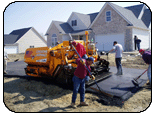 According to the Asphalt Institute:
According to the Asphalt Institute:
- Gravel must be installed on a properly prepared sub-base (firm ground no topsoil or wet clay)
- Asphalt must be installed on a proper gravel base that consists of 4”-6” limestone (best choice), crushed concrete or asphalt (second best), or crushed stone, not road gravel with a high clay content.
- Asphalt installation should equal a minimum of 3” compacted asphalt (not uncompacted) installed in two separate lifts to achieve maximum compaction.
- Finished elevation should facilitate water runoff and eliminate the possibility of water ponding. Contractor will guarantee 95% water drainage off the surface of the asphalt: Contractor will guarantee 100% water drainage away from structures. (sidewalk, garage, barn, house, ect.)
- Customer should be supplied with asphalt weight tickets to ensure the proper quantity of asphalt was used to facilitate the proper thickness of asphalt according to the square footage of the project.
- Contractor will hand compact all edges of asphalt to prevent cracking, raveling, and create a smooth appearance of asphalt.
- Contractor will provide a minimum of a 1-year guarantee on all defects caused by the material and workmanship, including improper drainage. (Creative Asphalt provides a 2-year guarantee).
- Contractor will provide the customer with all required insurance coverage upon request.
Creative Asphalt is a certified, accredited and licensed applicator of Streetprint.
Asphalt stamping delivers the look you want for less than other decorative paving systems on the market today. Whether you want to transform your driveway into a decorative masterpiece or just add accent colors, Creative Asphalt has a solution that meets your taste and your budget.
Innovative Decorative Paving System
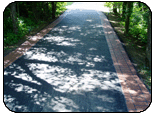 Streetprint is the most innovative decorative paving system developed in the last thirty years. It gives customers the beauty of hand-placed decorative products. The patterns are stamped into the new or existing asphalt.
Streetprint is the most innovative decorative paving system developed in the last thirty years. It gives customers the beauty of hand-placed decorative products. The patterns are stamped into the new or existing asphalt.
Beauty
Streetprint gives asphalt the decorative look of brick or stone designs in a broad range of patterns, colors and custom configurations. You can use this to turn one of the single largest features of your property into a decorative gem. Streetprint produces a beautiful 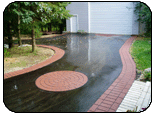 alternative to brick pavers and stamped concrete without their inherent drawbacks. More importantly is the long-term beauty of Streetprint. Should the surface ever suffer damage in its structure or color, asphalt repairs can be accomplished by simply re-heating and re-stamping the surface and applying a fresh layer of polymer cement surfacing material. Streetprint is a great alternative to stamped concrete, which has noticeable expansion joints or brick pavers where individual pieces can pop or heave.
alternative to brick pavers and stamped concrete without their inherent drawbacks. More importantly is the long-term beauty of Streetprint. Should the surface ever suffer damage in its structure or color, asphalt repairs can be accomplished by simply re-heating and re-stamping the surface and applying a fresh layer of polymer cement surfacing material. Streetprint is a great alternative to stamped concrete, which has noticeable expansion joints or brick pavers where individual pieces can pop or heave.
Durability
 Streetprint is a continuous, flexible surface of an asphalt substrate that resists cracking and lifting. Cracking and lifting is a frequent problem with real brick and stamped concrete. Water can penetrate through expansion joints in stamped concrete, and seams in brick pavers, causing cracking and lifting during subsequent freeze/thaw cycles. Streetprint structured asphalt includes a protective poly/cement surfacing system that extends the life of your asphalt pavement. The inherent flexibility of the substrate, combined with the surfacing system, provides a decorative surface which is far more resistant to penetration of water and plant growth.
Streetprint is a continuous, flexible surface of an asphalt substrate that resists cracking and lifting. Cracking and lifting is a frequent problem with real brick and stamped concrete. Water can penetrate through expansion joints in stamped concrete, and seams in brick pavers, causing cracking and lifting during subsequent freeze/thaw cycles. Streetprint structured asphalt includes a protective poly/cement surfacing system that extends the life of your asphalt pavement. The inherent flexibility of the substrate, combined with the surfacing system, provides a decorative surface which is far more resistant to penetration of water and plant growth.
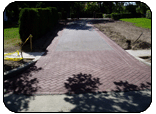 Installation
Installation
Streetprint is installed on top of new or existing asphalt. The asphalt must be sound and in solid shape. You would not want to put this product on old and cracking asphalt.
Quick Installation
 Streetprint can be installed very quickly with relatively little disruption. It costs much less and causes less disruption than concrete alternatives. Streetprint can be installed on either old or existing asphalt.
Streetprint can be installed very quickly with relatively little disruption. It costs much less and causes less disruption than concrete alternatives. Streetprint can be installed on either old or existing asphalt.
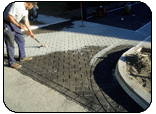 Easy to Repair
Easy to Repair
Unlike brick pavers, vehicle usage will not shift or break Streetprint. Streetprint is very easy to patch and virtually invisible when used in underground repairs.
Streetprint is ideal for
- Driveways
- Decorative Accents
- Walkways
- Borders
- Entrances
- Sidewalks
- Addresses
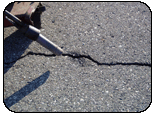 When considering any asphalt maintenance program, you should remember to address the causes of the deterioration of your parking lot. Cracks in parking lots are not unusual. Unfortunately, neither is the eventual deterioration of the surface if those cracks are left unattended. Unsealed cracks allow water to enter and deteriorate the sub-grade and eventually the surface, usually resulting in alligatoring, potholes, and general demise of the pavement. Hot crack filling is one of the less expensive methods of maintaining the lot condition, and one of the most effective solutions for extending the life of your lot.
When considering any asphalt maintenance program, you should remember to address the causes of the deterioration of your parking lot. Cracks in parking lots are not unusual. Unfortunately, neither is the eventual deterioration of the surface if those cracks are left unattended. Unsealed cracks allow water to enter and deteriorate the sub-grade and eventually the surface, usually resulting in alligatoring, potholes, and general demise of the pavement. Hot crack filling is one of the less expensive methods of maintaining the lot condition, and one of the most effective solutions for extending the life of your lot.
Hot Crack Sealer
Hot crack sealer is an elastic material designed to seal joints and cracks against this moisture infiltration into the sub-grade. Sub-grade moisture is one of leading causes of pavement failure, so it is essential that asphalt cracking is attended to promptly in order to extend the life of the pavement and save money long term. Typically, we recommend filling cracks and joints ¼ inch wide or greater.
The first step in high-quality crack filling is to ensure that the cracks to be filled are clean and dry. At Creative Asphalt we use a tool called a crack-jet. This machine produces 2800 deg. at 90 cfm. This ensures us that the crack will be cleaned of debris and vegetation and dried.
The final step is sealing the crack with hot applied rubber sealant. This final product is a flexible sealed crack, sealed from dirt & water, which will expand and contract with the extreme range of temperatures we face in Michigan.
There are many causes of cracks in asphalt pavement: oxidation from the sun, water penetration, freeze-thaw cycle, and a poor construction job are most common. Proper crack repair will prevent water from penetrating the crack, which provides a seal between the crack and the sub-grade.
Creative Asphalt has been a leader in this process of patching pavement, eliminating saw cut joints as with conventional patching.
Infrared repair is a cost effective method of asphalt repair. Infrared repair techniques are faster than “remove and replace” methods, and they don't leave a joint around the perimeter of the repair for water to seep into. Infrared machines heat the existing asphalt in and around the repair area to over 300 degrees. The heated asphalt can now be scarified. An asphalt rejuvenator is sprayed in the area to replace oils to the dried out asphalt. New asphalt is added as needed in the patch. The patched area is then finished, racked, and compacted. This is an attractive repair that has recycled the existing asphalt.
Infrared asphalt repair is intended for the mending of existing localized asphalt pavement distresses not caused by a weak sub base or poor quality of existing materials in adjacent areas.
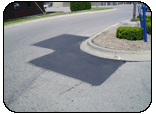 • Potholes
• Potholes
• Sunken utility cuts
• Catch basins
• High & low spots
• Large cracks
• Oil spots
• Handicap ramps/speed bump installation
 Causes of Asphalt Failure
Causes of Asphalt Failure
The most common causes of asphalt failure include.
- Water accumulation in areas of low elevation, both on the surface of the asphalt and under it. Excess water can cause asphalt to crack and split severely when temperatures fall below freezing. This is commonly referred to as alligatoring in the paving industry. Water collecting under the pavement can allow the sub-base to be soft and not support the weight on top of the asphalt, causing cracking.
- Overweight trucks such as large dump trucks and garbage trucks can cause the asphalt to sink or displace.
- Chemical spills and leaks such as gasoline, power steering fluid, and transmission fluid, deteriorate asphalt.
- Insufficient thickness of asphalt that does not have proper weight distribution capabilities.
 Remove & Replace, or R&R, is used in cases of severe deterioration, especially when the underlying base has been affected. The damaged areas are squared off back to good asphalt (solid ground).The asphalt is saw cut and removed. Upon excavation the sub-base is inspected for failure. The depth of excavation is determined when we reach solid dry soil. New aggregate is then added, and compacted in preparation for the new asphalt surface. Finally, hot-mixed asphalt is placed in separate lifts and compacted.
Remove & Replace, or R&R, is used in cases of severe deterioration, especially when the underlying base has been affected. The damaged areas are squared off back to good asphalt (solid ground).The asphalt is saw cut and removed. Upon excavation the sub-base is inspected for failure. The depth of excavation is determined when we reach solid dry soil. New aggregate is then added, and compacted in preparation for the new asphalt surface. Finally, hot-mixed asphalt is placed in separate lifts and compacted.
The mill & replace method is more versatile. The fact that not all of the existing asphalt has to be removed helps stretch your maintenance dollar. The asphalt is milled as necessary (typically 1” to 2”) and removed. The area is thoroughly cleaned and a tack coat is applied for better adhesion between the asphalt layers. We install new asphalt as necessary then compact to bring the area back up to level grade. This method has similar results as R&R and is somewhat more economical. However, mill & replace and infrared repair is not recommended if there is sub-base failure!

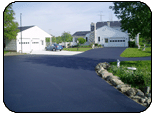
 Decorative Asphalt Paving
Decorative Asphalt Paving  Infrared Repairs
Infrared Repairs 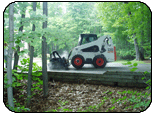 Mill & Replace
Mill & Replace 